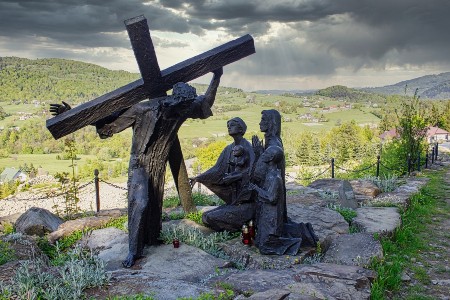Archaeological Discovery Affirms Biblical Account of Angelic Protection in Jerusalem
FREE Catholic Classes
New archaeological evidence has emerged that may corroborate a biblical story of God's angels defending Jerusalem from an Assyrian assault.

The Assyrian Empire was one of the most powerful ancient civilizations, renowned for its military prowess and advanced infrastructure. The Assyrians were also extremely brutal to those they conquered.
Highlights
7/26/2024 (3 months ago)
Published in Middle East
Keywords: Ancient Military Base, Jerusalem, Angel of the Lord, Assyrian Empire, Biblical Evidence, Archaeology
According to scripture, approximately 2,700 years ago, the Lord sent an angel to combat an invading army of Assyrian soldiers intent on conquering the Holy Land.
The Bible recounts that the Angel of the Lord descended upon the Assyrian military camp, resulting in the miraculous demise of 185,000 soldiers in a single night.
Despite the lack of previous archaeological evidence supporting this supernatural event or the battle itself, modern mapping techniques have led archaeologist Stephen Compton to claim he has discovered more proof of this epic confrontation.
King Sennacherib, who ruled the Assyrian Empire from 705 to 681 BC, laid siege to Jerusalem in an effort to dominate all routes leading to the Mediterranean Sea. Historical drawings from Sennacherib's palace, coupled with aerial images of Jerusalem from the 1930s, have provided Compton with valuable comparisons.
The palace carvings depicted the layout of the military base, enabling Compton to identify an area matching these drawings in photos taken during the 1910s. This led to the discovery of ruins featuring the remains of a perimeter wall and pottery shards.
After conducting a thorough archaeological survey, Compton determined that the site had been abandoned following Sennacherib's invasion and had not been inhabited for at least 2,600 years.
This significant finding opens the possibility for researchers to identify other similar military sites in the region, potentially uncovering ancient cities destroyed by the Assyrian Empire.
In 2021, Compton announced on X (formerly Twitter) that he had located Sennacherib's military camps. Each camp, identified by its Arabic name "Mudawwara," was situated a little over a mile north of the old city walls.
The name "Khirbet al Mudawwara," meaning "The ruins of the camp of the invading ruler," confirmed the site where Sennacherib's forces had planned their attack.
Prior to Compton's discovery, only one other ancient military campsite in the area had been identified, which was occupied during the Roman siege of Jerusalem. The distinct oval shape of the Assyrian camps contrasted with the rectangular Roman camps, providing further evidence of their origins.
Compton's methods have since led to the identification of additional Assyrian military camps and, in some cases, the sites of ancient cities besieged by the Assyrians.
The Bible passages in Isaiah 37:36-38, 2 Kings 19:35, and 2 Chronicles 32:21 describe how the Assyrian soldiers were slain the night before they could attack Jerusalem. The angel of the Lord, referred to in Hebrew as "malak Yahweh," was sent by God to protect Jerusalem after King Hezekiah prayed for divine intervention.
Various retellings of the event suggest different causes for the Assyrians' demise, including a plague or mice chewing through their bowstrings and shield straps, rendering them defenseless.
After the Assyrian army's defeat, the hill remained undisturbed until the 1930s when the British converted it into an ammunition storage depot. In 1948, the Jordanian army captured the hill, fortifying it with trenches, and two decades later, Israeli paratroopers seized it during the Six-Day War.
Today, the site stands as a memorial and museum, dedicated to the battle that claimed the lives of 15,000 Arabs and around 1,000 Israelis, serving as a testament to the enduring legacy of Jerusalem's divine protection.
Join the Movement
When you sign up below, you don't just join an email list - you're joining an entire movement for Free world class Catholic education.
-

-
Mysteries of the Rosary
-
St. Faustina Kowalska
-
Litany of the Blessed Virgin Mary
-
Saint of the Day for Wednesday, Oct 4th, 2023
-
Popular Saints
-
St. Francis of Assisi
-
Bible
-
Female / Women Saints
-
7 Morning Prayers you need to get your day started with God
-
Litany of the Blessed Virgin Mary
Daily Catholic
 Daily Readings for Friday, November 22, 2024
Daily Readings for Friday, November 22, 2024 St. Cecilia: Saint of the Day for Friday, November 22, 2024
St. Cecilia: Saint of the Day for Friday, November 22, 2024 St. Gertrude's Guardian Angel Prayer: Prayer of the Day for Friday, November 22, 2024
St. Gertrude's Guardian Angel Prayer: Prayer of the Day for Friday, November 22, 2024- Daily Readings for Thursday, November 21, 2024
- St. Gelasius: Saint of the Day for Thursday, November 21, 2024
- Act of Consecration to the Holy Spirit: Prayer of the Day for Thursday, November 21, 2024
![]()
Copyright 2024 Catholic Online. All materials contained on this site, whether written, audible or visual are the exclusive property of Catholic Online and are protected under U.S. and International copyright laws, © Copyright 2024 Catholic Online. Any unauthorized use, without prior written consent of Catholic Online is strictly forbidden and prohibited.
Catholic Online is a Project of Your Catholic Voice Foundation, a Not-for-Profit Corporation. Your Catholic Voice Foundation has been granted a recognition of tax exemption under Section 501(c)(3) of the Internal Revenue Code. Federal Tax Identification Number: 81-0596847. Your gift is tax-deductible as allowed by law.






 Daily Readings for Friday, November 22, 2024
Daily Readings for Friday, November 22, 2024 St. Cecilia: Saint of the Day for Friday, November 22, 2024
St. Cecilia: Saint of the Day for Friday, November 22, 2024 St. Gertrude's Guardian Angel Prayer: Prayer of the Day for Friday, November 22, 2024
St. Gertrude's Guardian Angel Prayer: Prayer of the Day for Friday, November 22, 2024


